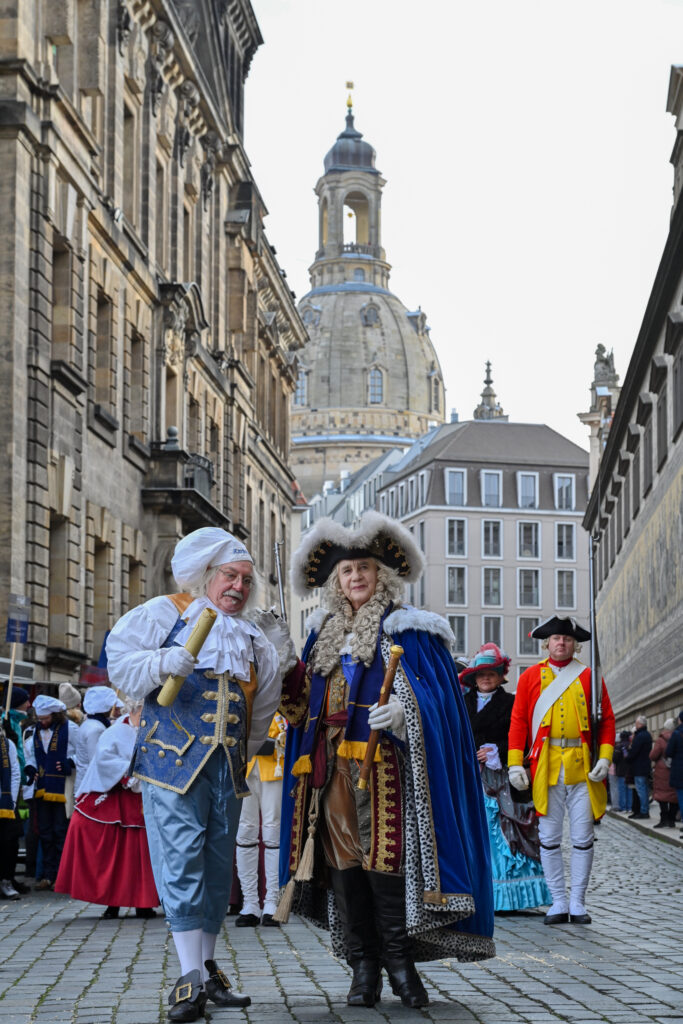Das Dresdner Stollenfest
DAS HIGHLIGHT DER WEIHNACHTSSTADT DRESDEN
30. Dresdner Stollenfest
am 6. Dezember 2025
Ein großer Festumzug, der XXL-Striezel, eine sympathische Schirmherrin und Hunderte stolze Stollenbäckerinnen und Stollenbäcker: Das sind die Zutaten für den vorweihnachtlichen Veranstaltungshöhepunkt der sächsischen Landeshauptstadt – das Dresdner Stollenfest. Seit 1994 widmen die Mitglieder des Schutzverbandes Dresdner Stollen e. V. ihrem Dresdner Christstollen ein eigenes Fest. Gemeinsam mit Zehntausenden Gästen aus aller Welt feiern sie die jahrhundertealte Backtradition, das lebendige Handwerk und vor allem eines – den ganz besonderen weihnachtlichen Genuss. Alljährlich am Samstag vor dem 2. Advent. Mehr Infos zum Fest gibt es schon bald hier.
So wird das Jubiläums-Stollenfest am 6. Dezember 2025
ZEIT
AKTION
ab 09:45 Uhr
Barockes Treiben vor dem Kulturpalast
ab 10:00 Uhr
Feierliche Eröffnung des Dresdner Stollenfestes
gegen 11:00 Uhr
Start des großen Festumzuges mit historischen Bildern und jeder Menge Puderzuckerzauber durch die historische Altstadt
gegen 12:00 Uhr
Ankunft des Festumzuges an der Bühne vor dem Kulturpalast
kurz nach 12:00 Uhr
Anschnitt des Riesenstollens
ab ca. 12:15 Uhr
Verkauf des Riesenstollens & Musik und Talk rund um den Dresdner Christstollen
gegen 15:30 Uhr
Veranstaltungsende

RIESENSTOLLEN FÜR DEN GUTEN ZWECK
Unser Engagement für die Region
Das Dresdner Stollenfest nimmt der Schutzverband Dresdner Stollen e. V. traditionell zum Anlass, alljährlich ein regionales Projekt zu unterstützen – in Form einer großzügigen Spende. 2024 ging ein Teil des Erlöses an die Stiftung Lichtblick e. V., die mit dem Geld die Initiativen Brotzeit e. V. sowie Drobs e. V. unterstützte.
STOLLENFEST-GALERIE
Ganz Dresden im Puderzuckerzauber










DIE STOLLENFEST-HISTORIE
Barocker Ursprung – So war das allererste Stollenfest
Zwinger, Hofkirche, Jagdschloss Moritzburg: Ohne August den Starken, Kurfürst von Sachsen und König von Polen, wäre der Freistaat um einige Sehenswürdigkeiten ärmer. Ganz sicher ist auch, dass es ohne Sachsens berühmtesten Wettiner heute kein Dresdner Stollenfest geben würde.
Das Zeithainer Lustlager – Ursprung des Dresdner Stollenfestes. Um nach Ende des Großen Nordischen Krieges die Stärke seiner Streitmacht zu demonstrieren, lud Friedrich August I. im Frühjahr 1730 Adelige und Militärs aus ganz Europa zu einer Heeresschau ein. Mit dem größten und prunkvollsten Barockfest aller Zeiten, dem Zeithainer Lustlager, unterstrich er aber nicht nur seine militärische Macht, sondern auch sein Faible für rekordverdächtige Aktionen: Der Höhepunkt des Festes war ein riesiger, etwa 1.800 Kilogramm schwerer Christstollen, welcher der Kurfürst anlässlich des Lustlagers vom Dresdner Bäckermeister Johann Andreas Zacharias und 60 Bäckerknechten backen ließ.
Mit dem großen Dresdner Stollenmesser in 24 000 Portionen aufgeteilt, wurde das 18 Ellen (etwa 7 Meter) lange und 8 Ellen (etwa 3 Meter) breite Gebäck an Festgäste und Soldaten verteilt. Der Kupferstich des Künstlers Elias Baeck zeugt noch heute von diesem Spektakel. Er lässt die Herausforderungen erahnen, welchen sich die Bauleute um Matthäus Daniel Pöppelmann gegenüber sahen, die damit beauftragt waren, einen Ofen für Augusts Feststollen zu konstruieren und zu bauen.
Heute gilt das Barockfest als Ursprung des Dresdner Stollenfestes. Anfang der 1990er Jahre forschte der Kunst- und Kulturexperte Dr. Peter Mutscheller im Auftrag der Hommage Dresden GmbH nach alten, in Vergessenheit geratenen Handwerkstraditionen. Während seiner Recherchen im Kupferstichkabinett der Elbmetropole entdeckte er das Zeugnis des barocken Gelages. Die Idee für das Dresdner Stollenfest war geboren.
264 Jahre nach dem Zeithainer Lustlager, im Jahr 1994, wurde so erneut ein 1.800 Kilogramm schwerer Dresdner Christstollen gebacken und präsentiert – diesmal aber nicht in Zeithain, sondern direkt in der historischen Dresdner Altstadt – beim ersten Dresdner Stollenfest.
Bereits im Jahr eins feierten Tausende Dresdner und deren Gäste das Traditionsgebäck. Heute gilt das Fest als das Highlight im vorweihnachtlichen Dresden.



